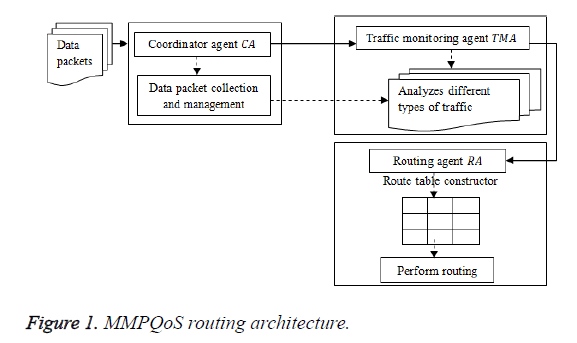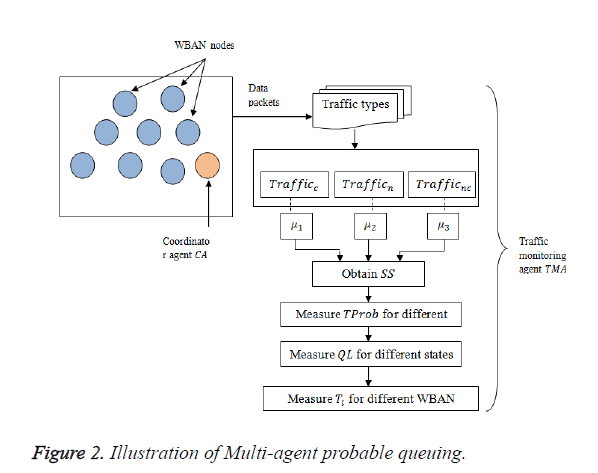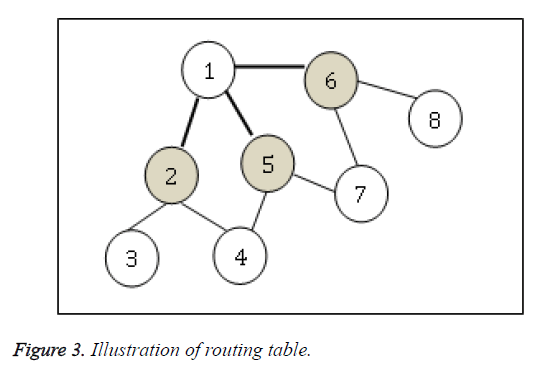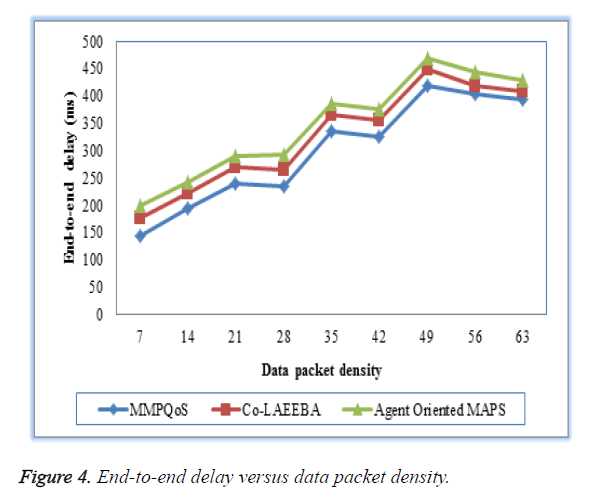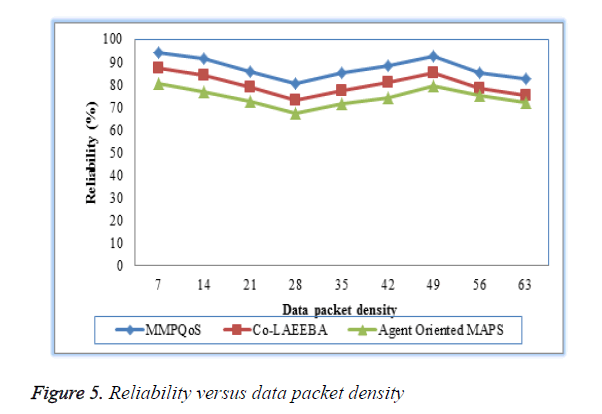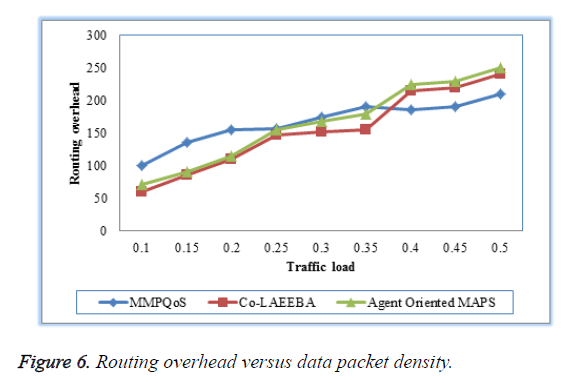ISSN: 0970-938X (Print) | 0976-1683 (Electronic)
Biomedical Research
An International Journal of Medical Sciences
Research Article - Biomedical Research (2017) Volume 28, Issue 9
Multi-agent based Maxmin Markov probability for QOS aware routing in WBAN
Wireless body area networks (WBANs) including implanted biosensors are mainly used for monitoring and diagnosing health related issues. However, providing Quality of Service (QoS) is a striking requirement for diverse critical applications in WBANs. In this paper, an agent based QoS-aware Routing framework called Multi-agent Markov Probable (MMPQoS) for WBAN is designed. A multiagent framework is proposed with the aim of ensuring desired critical QoS demands along with routing framework. The coordinator agent in MMPQoS framework coordinates the data packets and manages them through traffic monitoring agent. The traffic monitoring agent measures the transition probability and queue length for different state space using Markov Probable QoS-aware queuing model, ensuring end-to-end delay and reliability for critical data packets transmission. The routing agent then constructs the QoS-aware Route table constructor using MAXMIN policy, i.e., obtaining maximum trustworthiness for link with minimum queue length. The performance of MMPQoS has been evaluated through simulation which demonstrates that the framework achieves desired QoS demands while maintaining low end-to-end delay with reliable delivery of critical packets in the network compared to the state-ofthe- art QoS-aware approaches.
Keywords
Wireless body area networks, Quality of Service, Routing, Multi-agent, Markov probable.
Introduction
The mobility of a patient in WBAN may require a change of the dedicated display mechanism that monitors and displays patient critical data in an intermittent manner. In order to resolve these critical data related issues in WBAN, a new QoS based routing model for reliable critical data packet transmission is required. Link aware and Energy Efficient protocol for WBAN was designed in a study by Ahmed et al. [1] with the objective of learning and selecting the most feasible route minimizing the residual energy was presented. However, it did not enable rapid prototyping. To address this issue, an agent-based model using star-based design was constructed in a study by Aiello et al. [2], ensuring activity recognition accuracy. Indeed, remote healthcare monitoring techniques is highly expected to minimize unnecessary hospitalizations by reducing the length of patient stay whenever admission is required. This in turn reduces the patient’s engagement, regardless of their location, making timely intervention through real-time data monitoring.
In a research by Elhadja et al. [3], Multi Attribute Decision Making (MADM) methods was designed to reduce the packet overhead and number of handovers based on network history and user preference. Yet another integrative platform, Integrated Health Monitoring System (IHMS) based on multi-agent model was designed in [4] and therefore improved the elder’s life quality. However, optimization remained unaddressed. To address this issue, an optimization model using Genetic Algorithm [5] was designed. Despite, optimization and minimizing the packet overhead, security aspects remained unaddressed. To resolve this issue, a hybrid security model for inter and intra-WBAN communications was provided [6]. The security management framework in work by Reddy et al. [7] was planned for detecting the issues which improves the security level and performance with better effectiveness. However, the cost for security application and the management overhead are maximized.
Very few researchers have considered mechanisms and topology design for Wireless Body Area Networks. In a study by Elias and Mehaoua [8], an integer linear programming model was designed to provide energy efficient and cost effective WBAN model. Another method] was designed for providing energy efficiency using integer programming model [9]. However, multi objective remained unaddressed. In a research by Misray et al. [10], a cooperative bargaining solution was constructed using efficient data rate tuning mechanism. This resulted in average data rate increase having critical physiological data to be transmitted. Another model for ensuring quality of service was provided in employing slot allocation, priority mechanism, admission control and cross layer design [11].
In this paper, we propose a new QoS-aware Routing framework called Multi-agent Markov Probable (MMPQoS) for WBAN, which is an extension of Co-LAEEBA [1]. We compare its working with Co-LAEEBA [1] and Agent Oriented MAPS [2]. The proposed framework, based on Multi-agent framework, guarantees reliable delivery of critical data packets by classifying the traffic types through probable queuing algorithm. A mathematical model is also presented in this paper which is based on a state space model in which Exponential Moving Average is employed. Finally, MAXMIN QoS-aware Route table constructor is modeled for ensuring efficient routing through link trustworthiness and queue length respectively. Rest of the paper is organized as follows. Section 2 provides some related work. Section 3 describes the proposed framework, Multi-agent Based Markov Probable QoS-aware routing for WBAN. Experimental settings are provided in Section 4 and simulation results are provided in Section 5. Concluding remarks of the paper is provided in Section 6.
Related Works
Many routing methods for WBANs were designed taking into consideration different aspects, like, successful transmission of data, reliability of critical patient data to be transmitted, energy consumption with optimized used of available resources and so on. One of the most important concerns for WBAN is ensuring energy efficiency, where the sensor nodes operate in close proximity to, on or even inside a human body. In a study by Yi et al. [12], an energy consumption model with respect to transmission distance and transmission data rate over wireless communication link was designed, ensuring energy saving improving proportion of transmission energy. A Virtualization Enabled routing was designed with the objective of reducing the traffic congestion and packet delay [13].
A new mechanism for providing emergency networking to ensure reliable and high data rate communication for public safety with acceptable levels of disruption to incumbent network communication is the need of the hour. In a study by lee et al. [14], Multi Agent Reinforcement-based Learning was modelled with significant improvement in terms of convergence time and conformance to the mission policies. In a study by Mahmood et al. [15], performance analysis with various routing protocols was designed. To recognize the human motion, window-based algorithm was used in work by Varkey et al. [16], on obtaining optimal features was designed. Sign Gesture Recognition method in a study by Jain and Kaluri [17] was designed to detect each and every gesture with maximum accuracy and the minimum effort. But, sign gesture recognition method is reduced to extract the features under dark portions and does not recognize the gestures of human. In order to increase the recognition rate, sign gesture recognition technique was developed with the aid of region growing, genetic algorithm and adaptive filter [18]. Feature extraction addresses the Speeded-Up Robust Features (SURF) algorithm that is essential to taken out the feature point efficiently. But, the accuracy of the SURF algorithm is reduced.
To develop and deliver the software to end user, authenticate its quality is the significant task. Software testing was performed to recognize the defects for improving the performance of the system using TestNG framework [19]. It focus automation testing tool for supporting the design and execution function which in turns reducing the effort and cost. Though, end-to end delay remains unaddressed. A distributed priority scheduling strategy to priority the transmission of current patient condition by ensuring end-to-end delay and reliability was designed [20]. Another patient data prioritization method was designed using cross layer design structure [21].
One of the emerging methods in WBAN is providing network coding-based error recovery mechanism to ensure QoS with low energy level, memory and hardware cost. Despite, providing recovery mechanism, in dynamic environments, network coding failed in supporint certain network QoS requirements. In a research by Razzaque et al. [22], QoS-aware error recovery mechanism with WBAN requirements, called, an adaptive network coding-based method was presented. An analysis of QoS aware health monitoring system was presented in work by Liao et al. [23]. A survey of body-to-body networks for ubiquitous healthcare was provided [24]. Despite energy efficiency and reliability, to improve QoS aware routing to develop agent oriented framework, in this work, a Multi-agent based Markov Probable QoS-aware Routing for WBAN that leverages the strengths and overcomes the weaknesses of existing QoS-aware routing methods is presented below.
Multi-Agent Based Markov Probable QoS-Aware Routing (MMPQoS) for Wireless Body Area Network
In this section, a routing framework for WBANs, called, Multi-agent Based Markov Probable QoS-aware Routing (MMPQoS) is constructed. Considering the routing under QoS constraint in mind, the end-to-end delay is minimized with reliable delivery of data packets between the nodes and therefore improving the routing efficiency. The framework is designed starting with the network model.
Network model
The set of WBAN nodes, ‘WN=wn1,wn2,…,wnn’, being energy constrained performs only the tasks of data packet ‘DP=dp1,dp2,…,dpn’ sensing and transmission. The actual communication between the WBAN nodes in the proposed framework is said to be performed by the Coordinator Agent denoted as ‘CA’, Traffic Monitoring Agent denoted as ‘TMA’, performs the job of data processing and management of traffic types.
The above said deployment is done in the MMPQoS framework using a connectivity graph, ‘G=(V,E)’, where ‘V={wn1,wn2,…,wnn}’is the set of vertices representing the WBAN nodes in the network, and ‘E’ is the set of edges representing the communication links between the WBAN nodes. Let us further assume that every WBAN node ‘WN’ uses transmission power of fixed range for communication and data packet transmission with the neighboring nodes in the network. Figure 1 shows the architecture of Multi-agent Based Markov Probable QoS-aware Routing (MMPQoS) for WBAN.
The MMPQoS constructs and maintains a routing table using three agents, namely, Coordinator Agent, Traffic Monitoring Agent and Routing Agent. Each agents coordinate with the other agents with the objective of ensuring QoS aware routing. Upon reception of data packets, the coordinator agent ‘CA’ performs the task of coordination between the nodes i.e., reception of data packets from the WBAN source nodes and broadcasting it to the traffic monitoring agent ‘TMA’ for further process.
The traffic monitoring agent on the other hand, analyzes the traffic and accordingly queues the traffic. Finally, the routing agent ‘RA’ identifies the QoS aware routing increasing the reliable delivery of critical packets, reducing the average end-to- end delay, therefore improving the total network operational lifetime. The elaborate description of MMPQoS framework is provided in the following sections.
Markov probable QoS-aware queuing model
In the MMPQoS framework, a Markov chain is constructed to extract the closed form data packets for different types of QoS (end-to-end delay and reliable delivery) in WBAN. Let us further assume that there are three types of traffic. The first type of traffic being the critical traffic ‘Trafficc’, having the highest priority, second type of traffic being the normal traffic ‘Trafficin’, having the mid-range priority and the third type of traffic being the non-critical traffic ‘Trafficnc’, having the lowest priority.
With three different types of traffic assumed in MMPQoS framework, the service distribution (i.e., state space) for these three types of traffic is given as ‘μ1’, ‘μ2’ and ‘μ3’ respectively. Figure 2 shows the illustration of Multi-agent Probable QoS-aware Queuing model.
Upon selecting the next hop(s), the data packets are passed to the Probable QoS-aware Queuing module, which maintains three separate queues for three types of traffic, namely, ‘Trafficc’ (i.e. type 1- critical traffic), ‘Trafficcn’ (i.e. type 2- normal traffic), and ‘Trafficnc’ (i.e. type 3 - non critical traffic) respectively. The ‘Trafficc’, has higher priority than that of ‘Trafficn’ and ‘Trafficnc’. It signifies that the data packets from ‘Traffic’ and ‘Trafficnc’ will not be sent until the ‘Trafficc’ becomes empty. With the application of Markov Chain for Probable QoS-aware Queuing module, the state space for WBAN nodes is derived. The state space for WBAN nodes is the number of data packets ‘DP’ arriving in queue plus the data packets to be served ‘S’ is expressed as below.
SS={(μ1,μ2,μ3,DP,S)}, where DP ϵ dp1,do2,dp3,S ϵ S1,S2,S3 → (1)
From (1), the state space ‘SS’ for WBAN nodes with service distribution ‘S’ for three different types of services ‘μ1’, ‘μ2’ and ‘μ3’ are obtained. Let us consider a scenario in which a transition is said to occur from ‘type 2’ to ‘type 3’, then, the transition probability is expressed as given below.
type 2<type 3 → TProb{Pn+1=(0,μ2-k, μ3-k, dp2, S2)| Pn=(μ1,μ2,μ3,dp1,S1)} → (2)
type 2<type 3 → TProb{Pn+1=(0,μ2-k, 0, dp2, S2)| Pn=(μ1,μ2,μ3,dp1,S1)} → (3)
Based on the above formulation, the transition probabilities for different states (type 2<type 3; type 2>type 3) are obtained. With this different states transition probabilities, let us obtained the queue length for type 1 data packet. It is then the number of data packets waiting in type 1 system that must reach the Traffic Monitoring Agent ‘TMA’ before this newly arrived type 1 data packet. The queue length is then formulated by ‘’ as given below.
QL[type 1]= (μ1,μ2,μ3,dp1,S1)+( μ1,μ2,μ3,dp1,S2)+ ( μ1,μ2,μ3,dp1,S3) → (4)
QL[type 2]= (μ1,μ2,μ3,dp1,S2)+( μ1,μ2,μ3,dp1,S3)+ ( μ1,μ2,μ3,dp1,S1) → (5)
QL[type 3]= (μ1,μ2,μ3,dp1,S3)+( μ1,μ2,μ3,dp1,S1)+ ( μ1,μ2,μ3,dp1,S2) → (6)
With the obtained queue lengths for each type of traffic from (4), (5) and (6), end-to-end delay is measured. Based on the queue lengths, trustworthiness (i.e. link) in MMPQoS framework measures the number of data packets sent from the WBAN source node ‘WN’ to the closed proximity node and the number of acknowledgment received from the closed proximity node respectively. The trustworthiness in the MMPQoS framework is evaluated using the Exponential Moving Average (EMA) model. The advantage of using the EMA model in the MMPQoS framework is that more weight is applied to the recent arrived data packets.
 → (7)
→ (7)
From (7), the link trustworthiness ‘Tl’ for source node ‘wni’ with closed proximity node ‘wnj’ is measured using the weighting factor ‘α’ depends upon the traffic types. More preference the traffic type, higher the weighting factor and vice versa. In addition, the data packets arrived ‘DPa’ and data packets sent ‘DPs’ are also considered. Algorithm 1 presents the procedure for the construction and update of state space, transition probabilities and queue length with optimized endto- end delay.
Algorithm 1 Probable Queuing algorithm:
Input: WBAN Nodes ‘WN=wn1,wn2,…,wnn’, Coordinator Agent ‘CA’, Traffic Monitoring Agent ‘TMA’, Data Packets ‘DP=dp1,dp2,…,dpn’, Traffic types ‘Trafficc, Trafficn,Trafficnc’,
Output: Optimized end-to-end delay
1: Begin
2: For each WBAN Nodes ‘WN’ with Data Packets ‘DP’ to be sent
3: For each traffic types
4: Measure state space using (1)
5: Measure transition probability using (2) and (3)
6: Measure queue length using (4), (5) and (6)
7: Evaluate link trustworthiness using (7)
8: End for
9: End for
10: End
The procedure for Probable Queuing is called whenever a data packet ‘DP’ is received by the Coordinator Agent ‘CA’ node. According to three different traffic types assumed in MMPQoS framework, three different measures are evolved. They are state space, transition probability and queue length. With this measured value, by giving higher preference to higher weighting factor, the end-to-end delay is said to be optimized by the traffic monitoring agent ‘TMA’ through the assignment of different weighting factors according to the traffic types in the network.
MAXMIN QoS-aware Route table constructor
Once a path is established between the WBAN nodes, data packets are broadcasted by Traffic Monitoring Agent ‘TMA’ at time interval ‘t’ to its neighbour WBAN nodes. The neighbouring WBAN nodes for each source WBAN node is obtained by evaluating the distance ‘Dis’ between the source ‘wnxi’ and the nodes other than the source nodes ‘wnyi’ in the network.
 (8)
(8)
In addition to the usual header information, the data packets include information like minimum queue length denoted as ‘MIN(QL)’ and maximum trustworthiness denoted as ‘MAX(T)’ respectively. Figure 3 illustrates an example for routing table and its corresponding routing table structure in Table 1.
| Neighbor node | Queue Length ‘QL’ QL(wni,wnj) |
Link Trustworthiness ‘Tl’ Tl(wni,wnj) |
|---|---|---|
| 2 | 0.05 | 0.15 |
| 5 | 0.08 | 0.25 |
| 6 | 0.07 | 0.13 |
Table 1. Illustration of data packet information.
As illustrated in the figure, the routing table for WBAN node ‘1’ is shown. The shaded nodes ‘2,5,6’ indicate probable nodes from ‘1’. From Figure 3, the WBAN node ‘1’ has three neighbor nodes ‘2,5,6’ respectively. Next, the routing table constructor by the routing agent is performed to set the values for each data packets. Therefore, after every time interval ‘t’, the following parameters for each data packet is measured as follows.
 (9)
(9)
 (10)
(10)
From (9) and (10), ‘Twni’, is set to maximum of all ‘Tl(wni,wnj)’, values, whereas ‘QLwni’ is set to minimum of all ‘QL(wni,wnj)’ values respectively.
With the above queue length and link trustworthiness measure, the Table 1 given in shows the WBAN node ‘1’ selecting the neighbor node ‘2’ with minimum queue length of ‘0.05’ compared to WBAN nodes ‘5’ and ‘6’. On the other hand the WBAN node ‘1’ selects the neighbor node ‘5’ with maximum link trustworthiness of ‘0.25’ compared to WBAN nodes ‘2’ and ‘6’ respectively. Algorithm 2 presents the procedure for construction and updating of MAXMIN QoS-Aware Routing algorithm.
Algorithm 2 MAXMIN QoS aware Routing algorithm:
Input: WBAN Nodes ‘WN=wn1,wn2,…,wnn’, Routing Agent ‘RA’, Data Packets ‘DP=dp1,dp2,…,dpn’
Output: Reduced routing overhead and improved routing efficiency
1: Begin
2: For each WBAN Nodes ‘WN’ with Data Packets ‘DP’ to be sent
3: Obtain neighboring nodes using (8)
4: For each neighboring nodes ‘wnxi’ and ‘wnyi’
5: Measure trustworthiness using (9)
6: Measure queue length using (10)
7: End for
8: End for
9: End
Upon obtaining ‘WN’ with Data Packets ‘DP’ to be sent by Traffic Monitoring Agent, WBAN node starts sending data packets received from the other nodes, or its own sensed data packets. At this juncture, the routing agent ‘RA’, constructs suitable route based on QoS aware routing. The QoS aware route selector module communicates with the routing table to select the next hop after receiving a data packet of particular type. Each WBAN node selects the next hop according to Algorithm 2. As proposed in algorithm 2, to start with, the neighbouring nodes are first obtained. Followed by which, trustworthiness and queue length is measured and accordingly, the route with high trustworthiness and lesser queue length is selected as the best route.
Performance Evaluation of MMPQoS
In this section, simulation results to demonstrate the efficiency of our proposed framework, MMPQoS is presented. To start with, the metrics used for performance evaluation is presented and then the framework MMPQoS is evaluated by comparing it with Cooperative Link-Aware and Energy Efficient protocol for wireless Body Area networks (Co-LAEEBA) [1] and Agent Oriented MAPS framework [2]. We will use (Co-LAEEBA) [1] and Agent Oriented MAPS framework [2] as a reference for performance evaluation as it aims to minimize the end-to-end delay and improves the success transmission rate with same characteristic as MMPQoS framework, for Wireless Body Area Network communication. The evaluation is accompanied with an analysis and discussion of results.
Performance parameters
We evaluate three key performance metrics. End-to-End delay End-to-end latency of a data packet is measured as the time difference between the data packet generation time and the time when it is received by the ‘TMA’. Delays experienced by distinct data packets are averaged over the total number of distinct packets received by the ‘TMA’.
 (11)
(11)
From (11), the end-to-end delay ‘EED’ is measured using the time required for data packets generation ‘DPgt’ and time required for data packets reception ‘DPrt’ with respect to the data packet density ‘DPi’ in the network. It is measured in terms of milliseconds (ms). Reliable delivery of critical data packets is the ratio of the total number of unique data packets received by the traffic monitoring agent ‘TMA’ to the total number of data packets generated by the WBAN nodes.
 (12)
(12)
From (12), the reliability of critical data packets ‘R’ is the ratio of the data packets received ‘DPr’ to the data packets sent ‘DPs’ at a particular time interval. It is measured in terms of percentage (%). Routing overhead [15] is the size of routing table per periodic route update time. While routing table size is equivalent to the size of network, combining it with the periodic message update, the routing overhead is given as below.
 (13)
(13)
From (13), the routing overhead is obtained using the ‘k’ adjustment routing protocol impulse factor, ‘n’ number of nodes in network with respect to the bandwidth ‘B’ with ‘Tpr’ being the probability during the first ‘r’ hops respectively.
Performance evaluation
The principal objective for conducting these simulations is to analyze the framework by comparing it with other methods, mainly Cooperative Link-Aware and Energy Efficient protocol for wireless Body Area networks (Co-LAEEBA) [1] and Agent Oriented MAPS framework [2]. To evaluate MMPQoS, the network simulator ns-2 [24] is used, with each simulation run performing with duration of 400 milliseconds. During each simulation, constant bit rate (CBR) connections are generated the WBAN source node produces seven packets per second with a packet size of 32 bytes. The number of WBAN sensor nodes is varied between 10 and 90 nodes to obtain different scenarios in a 1600 m*1600 m environment. The Random Waypoint model is used to simulate the multi agent movement, each agent and sensor node moving with a speed randomly chosen from 0 to 3 m/s. Each simulation is carried out under a different number of network nodes and the performance metrics are obtained by averaging over 9 simulation runs. The parametric values for performing experiments are shown in Table 2.
| PARAMETER | VALUE |
|---|---|
| Protocols | DSDV |
| Network range | 1600 m*1600 m |
| Simulation time | 400 ms |
| Data packet density | 7, 14, 21, 28, 35, 42, 49, 56, 63 |
| Data packet size | 32 bytes |
| Sensor node density | 10, 20, 30, 40, 50, 60, 70, 80, 90 |
| Network simulator | NS 2.34 |
| Mobility speed | 0 to 3 m/s |
| Pause time | 15 s |
| Simulation runs | 9 |
Table 2. Simulation setup.
Discussion
To validate the efficiency and theoretical advantages of the QoS-aware Routing framework called Multi-agent Markov Probable (MMPQoS) with Cooperative Link-Aware and Energy Efficient protocol for wireless Body Area networks (Co-LAEEBA) [1] and Agent Oriented MAPS framework [2], simulation results under NS2 are presented. The parameters of the MMPQoS framework are chosen as provided in the experiment section.
Scenario 1: End-to-end delay
To better understand the effectiveness of the proposed MMPQoS framework, with respect to end-to-end delay, extensive experimental results are reported in Table 3.
| Data packet density | End-to-end delay (ms) | ||
|---|---|---|---|
| MMPQoS | Co-LAEEBA | Agent Oriented MAPS | |
| 7 | 143 | 178 | 200 |
| 14 | 195 | 223 | 243 |
| 21 | 240 | 270 | 290 |
| 28 | 235 | 265 | 293 |
| 35 | 335 | 365 | 385 |
| 42 | 325 | 355 | 375 |
| 49 | 420 | 450 | 470 |
| 56 | 405 | 420 | 445 |
| 63 | 395 | 310 | 408 |
Table 3. Tabulation for end-to-end delay.
NS2 simulator is used to experiment end-to-end delay by analyzing the result using table and graph values. Results are presented for different data packet density and the results reported here confirm that with the increase in the data packet density, the end-to-end delay also gets increased, though not found to be linear.
Figure 4 shows the end-to-end delay based on the data packet density in WBAN considered for experimental purpose. Our proposed MMPQoS framework performs relatively well when compared to two other methods Co-LAEEBA [1] and Agent Oriented MAPS [2]. The end-to-end delay is reduced in the MMPQoS framework by applying Markov Probable QoS-aware Queuing model. By applying the Markov Probable QoS-aware Queuing model, efficient validation is performed by the traffic monitoring agent that divides the network according to the types of traffic, with ‘Trafficc’, having the highest priority, ‘Trafficn’, having the mid-range priority and the non-critical traffic ‘Trafficnc’, having the lowest priority. This in turn reduces the end-to-end delay using the MMPQoS framework by 11% compared to Co-LAEEBA. Moreover, the comparison of different traffic types by the traffic monitoring agent with that of the coordinating agent transition probability for different state space helps in reducing the end-to-end delay using MMPQoS by 19% compared to Agent Oriented MAPS.
Scenario 2: Reliability
As listed in Table 4, MMPQoS framework measures the reliability with respect to data packet density in the range of 7 to 63. It is measured in terms of percentage (%). The reliability in WBAN using MMPQoS framework offers comparable values than the state-of-the-art methods.
| Data packet density | Reliability (%) | ||
|---|---|---|---|
| MMPQoS | Co-LAEEBA | Agent Oriented MAPS | |
| 7 | 94.21 | 87.32 | 80.29 |
| 14 | 91.48 | 84.34 | 76.87 |
| 21 | 85.67 | 78.69 | 72.69 |
| 28 | 80.28 | 73.22 | 67.22 |
| 35 | 85.39 | 77.31 | 71.31 |
| 42 | 88.14 | 81.16 | 74.16 |
| 49 | 92.45 | 85.22 | 79.21 |
| 56 | 85.14 | 78.23 | 75.23 |
| 63 | 82.33 | 75.16 | 72.14 |
Table 4. Tabulation for reliability for critical data packets.
The targeting results of reliability for critical data packets using MMPQoS framework with two state-of-the-art methods [1,2] in Table 4 presented for comparison based on the data packet density in WBAN. Higher the reliability rate, more efficient the framework is said to be and more successful the transmission rate.
Figure 5 presents the variation of reliability of critical data packets transmission with respect to data packet density in wireless body area network. All the results provided in Figure 5 confirm that the proposed MMPQoS framework significantly outperforms the other two methods, Co-LAEEBA [1] and Agent Oriented MAPS [2]. The reliability of critical data packets transmission is improved in MMPQoS framework using the Probable Queuing algorithm. By applying the Probable Queuing algorithm, according to three different traffic types, three different measures are evolved. With these three different measures, namely, state space, transition probability and queue length provides an insight into assignment of different weighting factors according to the traffic types in the network. This in turn improves the reliability of critical data packets being transmission using MMPQoS by 8% compared to Co-LAEEBA and 15% compared to Agent Oriented MAPS [2].
Scenario 3: Routing overhead
To better understand the effectiveness of the proposed MMPQoS framework, extensive experimental results are reported in Table 5 with respect to routing overhead.
| Traffic load | Routing overhead | ||
|---|---|---|---|
| MMPQoS | Co-LAEEBA | Agent Oriented MAPS | |
| 0.1 | 100 | 60 | 72 |
| 0.15 | 135 | 85 | 90 |
| 0.2 | 155 | 110 | 115 |
| 0.25 | 157 | 147 | 155 |
| 0.3 | 175 | 152 | 168 |
| 0.35 | 190 | 155 | 180 |
| 0.4 | 185 | 215 | 225 |
| 0.45 | 190 | 220 | 230 |
| 0.5 | 210 | 240 | 250 |
Table 5. Tabulation for routing overhead
The targeting results of routing overhead using MMPQoS framework with two state-of-the-art methods [1,2] in Table 5 presented for comparison based on the traffic load in wireless body area network.
Figure 6 presents routing overhead versus different traffic load using three methods MMPQoS, Co-LAEEBA [1] and Agent Oriented MAPS [2]. This figure shows that MMPQoS causes more number of routing overheads when compared to two other methods namely, Co-LAEEBA [1] and Agent Oriented MAPS [2] mainly because maximum trustworthiness and minimum queue length are counted in the overhead. To explore the best performance delivery path, MMPQoS framework uses the MAX-MIN QoS aware Routing algorithm, by selecting the route based on maximum trustworthiness and minimum queue length. In Co-LAEEBA [1] and Agent Oriented MAPS [2], route is established based on the routing table for measuring the neighbouring nodes to the destination. Hence, if the current route path fails, the two methods [1] and [2] have to re-establish a new path from the scrap. This in turn consumes much more routing overhead. As a result, for networks with heavy traffic load, up to 40%, Co-LAEEBA [1] and Agent Oriented MAPS [2] consume more routing overhead than MMPQoS. When the traffic load percentage reached 50%, MMPQoS framework consumes less 11% and 4% routing overhead than Co-LAEEBA [1] and Agent Oriented MAPS [2], respectively. Therefore, our MAX-MIN QoS aware Routing algorithm is more suitable than compared to the state-of- the-art works.
Conclusion
This paper presents MMPQoS, a MAXMIN Markov Probable QoS aware Routing framework for wireless body area networks that mainly concerns about achieving QoS requirements of different application types throughout the network. MMPQoS is a probable queuing model that maintains separate queues for different types of traffic through state space model. It exploits cross-layer functionality through estimating transition probability and queue length to construct and update the state space. MMPQoS employs a MAXMIN principle to construct routing table that includes maximum link trustworthiness and minimum queue length for diverse QoS demands of traffic types. To evaluate the efficiency of MMPQoS, extensive simulations comparing MMPQoS with Co-LAEEBA and Agent Oriented MAPS were performed. The results reveal that MMPQoS achieves significant lower end-to-end delay and higher reliability performance for critical data packets transmission as compared to both Co-LAEEBA and Agent Oriented MAPS. MMPQoS framework also maintains a moderate average routing overhead throughout the network. In summary, MMPQoS successfully ensures the desired QoS demands of diverse traffic types, maintains moderate routing overhead in the entire network.
References
- Ahmed S, Javaid N, Yousaf S, Ahmad A, Sandhu MM, Imran M, Khan ZA, Alrajeh N. Co-LAEEBA: Cooperative link aware and energy efficient protocol for wireless body area networks. Comput Human Behav 2015; 51:1205-1215.
- Aiello F, Bellifemine FL, Fortino G, Galzarano S, Gravina R. An agent- based signal processing in-node environment for real-time human activity monitoring based on wireless body sensor networks. Eng Appl Artific Intell 2011; 24: 1147-1161.
- Elhadja HB, Elias J, Chaari L, Kamoun L. Multi Attribute Decision Making Handover Algorithm for Wireless Body Area Networks. Comput Commun 2016; 81: 97-108.
- Lasheng Y, Jie L, Beiji Z. Research on a Multi-agent Based Integrated Health Monitoring System for the Elderly at Home. Future Wireless Networks Inform Syst 2012; 143: 155-161.
- Kachroo R, Bajaj R. A Novel Technique for Optimized Routing in Wireless Body Area Network using Genetic Algorithm. J Network Commun Emerg Technol (JNCET) 2015; 2: 90-97.
- Irum S, Ali A, Khan FA, Abbas H. A Hybrid Security Mechanism for Intra-WBAN and Inter-WBAN Communications. Int J Distribut Sensor Networks 2013.
- Reddy GT, Sudheer K, Rajesh K, Lakshmanna K. Employing Data Mining On Highly Secured Private Clouds For Implementing A Security-As A-Service Framework. J Theor Appl Informa Technol 2014; 59: 317-326.
- Elias J, Mehaoua A. Energy-aware Topology Design for Wireless Body Area Networks. IEEE International Conference on Communications (ICC), 2012.
- Elias J. Optimal design of energy-efficient and cost-effective Wireless Body Area Networks. Ad Hoc Networks 2014; 13: 560-574.
- Misray S, Moulikz S, Chao HC. A Cooperative Bargaining Solution for Priority-based Data-rate Tuning in a Wireless Body Area Network. IEEE Transact Wireless Commun 2015; 14: 2769-2777.
- Sevin A, Bayilmis C, Kirbas I. Design and implementation of a new quality of service-aware cross-layer medium access protocol for wireless body area networks. Comput Elect Eng 2016.
- Yi C, Wang L, Li Y. Energy Efficient Transmission Approach for WBAN Based on Threshold Distance. IEEE Sensors J 2015; 15: 5133-5141.
- Porxas AX, Liny SC, Luoz M. QoS-Aware Virtualization-Enabled Routing in Software-Defined Networks. IEEE International Conference on Communications (ICC), 2015.
- Lee EK, Viswanathan H, Pompili D. RescueNet: Reinforcement-learning-based communication framework for emergency networking. Computer Networks 2016; 98: 14-28.
- Mahmood D, Javaid N, Qasim U, Khan ZA. Routing Load of Route Calculation and Route Maintenance in Wireless Proactive Routing Protocols. International Conference on Broadband, Wireless Computing, Communication and Applications, 2012.
- Varkey JP, Pompili D, Walls TA. Human motion recognition using a wireless sensor-based wearable system. Personal and Ubiquitous Computing 2012; 16: 897-910.
- Kaluri R, Reddy P. Sign Gesture Recognition Using Modified Region Growing Algorithm and Adaptive Genetic Fuzzy Classifier. Int J Intell Eng Syst 2016; 9: 225-233.
- Kaluri R, Reddy PC. A framework for sign gesture recognition using improved genetic algorithm and adaptive filter. Cogent Eng 2016; 3: 1251730.
- Jain RC, Kaluri R. Design of Automation Scripts Execution Application for Selenium Webdriver and TestNG Framework. ARPN J Eng Appl Sci 2015; 10: 2440-2445.
- Chen B, Pompili D. Transmission of Patient Vital Signs UsingWireless Body Area Networks. Mobile Networks Appl 2011; 16: 663-682.
- Ullah F, Abdullah AH, Jan MQ, Qureshi KN. Patient Data Prioritization in the Cross-Layer Designs of Wireless Body Area Network. J Comput Networks Commun 2015.
- Razzaque MA, Javadi SS, Coulibaly Y, Hira MT. QoS-Aware Error Recovery in Wireless Body Sensor Networks Using Adaptive Network Coding. Sensors 2015.
- Liao Y, Leeson MS, Higgins MD, Bai C. Analysis of In-to-OutWireless Body Area Network Systems: Towards QoS-Aware Health Internet of Things Applications. Electronics 2016.
- http://www.isi.edu/nsnam/ns
